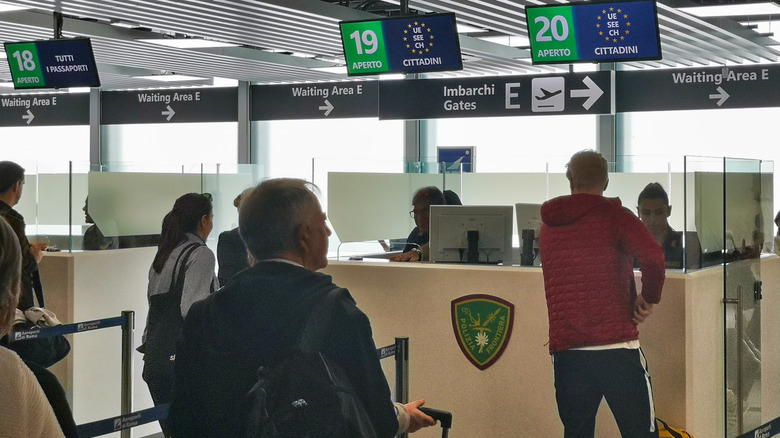What Tourists Need To Know About Europe's New Entry/Exit System Before Planning A Trip
If you are planning to go to Europe after mid-October — say to the surfing capital of Europe, the unforgettable hiking destinations recommended by Rick Steves, or to explore the picturesque beaches and limestone cliffs in Italy – then familiarizing yourself with the EES is essential. The Entry/Exit System (EES), is set to launch on October 12, 2025. This is a transformative step for travel to and around Europe that aims to replace outdated manual passport stamping with a streamlined, automated IT system. The EES is designed to register non-EU nationals traveling for short stays, which is defined as up to 90 days within any 180-day period. The EES will apply to the 29 Schengen Area countries, which includes Iceland, Liechtenstein, Norway, and Switzerland, even though they're not part of the European Union. Travelers from countries like the U.S., Canada, Australia, and Japan will need to comply, while those holding passports from Schengen countries, Cyprus, or Ireland are exempt. Managed by the eu-LISA (the European Union Agency for the Operational Management of Large-Scale IT Systems), the EES ensures centralized data management for consistency across borders.
The system's main objectives are multifaceted. It aims to enhance border security, prevent irregular migration, identify overstays, and combat identity fraud through the collection of biometric data, which includes fingerprints and facial images. By digitalizing entry, exit, and refusal records, the EES provides real-time data sharing among border authorities to ensure accurate tracking and improved real-time decision making. This modernization promises long-term benefits, such as faster border crossings and more reliable data to address security concerns. For tourists, the shift means adapting to a new process, but one that prioritizes safety and eventually efficiency. Understanding the EES is crucial for anyone planning a European trip. It's not just a bureaucratic change but a move toward a more secure and connected Schengen Area, setting the stage for a smoother travel experience.
What to expect at the border
Crossing Schengen borders after October 12, 2025, will feel very different for all non-EU travelers. On the first visit, tourists will need to provide biometric data, including fingerprints and a facial image, alongside personal details like their legal name, date of birth, and travel plans. This information will be taken at automated kiosks, dedicated booths, or through border officers at airports, ports, or land crossings, depending on how the country has it set up. This digital record is valid for three years, and fully replaces the traditional passport stamp, in the hopes of making future visits faster with just a passport scan and biometric verification. Some borders might offer self-service systems or mobile apps to pre-register data, which could speed up the implementation of the program. Those exempt from EES registration include long-term Schengen residents and holders of long-stay visas, who bypass this process entirely.
In addition to the potential benefits, the initial rollout of the program may also bring some challenges. Experts warn of longer queues, particularly at high-traffic entry points like the Port of Dover, the Channel Tunnel (both of which connect England with France), or St. Pancras train station in London, where delays could stretch significantly, especially during peak seasons such as holidays or summers. Travelers should arrive early and exercise patience as border staff and systems adjust. Preparing for potential delays and understanding the new procedures can help ease the transition. The EES aims to make border crossings more efficient over time, but the early days may test the patience of travelers. Anticipating these changes and allowing for extra time will let you navigate the process with more ease and confidence.
Preparing for your trip and future implications
To prepare for the EES, tourists should stay updated through reliable resources like the EU's Travel Europe website or their home country's travel advisories. Unlike some travel systems, the EES requires no pre-travel registration, and data collection can happen entirely at the border – making it all the more important to arrive early and expect delays, especially during peak holidays and travel periods. Planning for these delays can make the difference between a stressful start and a smooth entry into the Schengen Area.
Looking ahead, the EES ties into the upcoming European Travel information and Authorization System (ETIAS), which is expected to roll out in late 2026. ETIAS requires visa-exempt travelers to apply online for a $10 authorization (or free for those under age 18 or above 70), which is valid for 3 years. This pre-approval, which is checked by airlines during the check-in process, complements the EES by screening travelers before they reach the border. Together these systems aim to streamline travel while enhancing security and safety, and eventually reducing congestion.
Privacy concerns are natural with EES' collection of biometric and personal data, including full names, dates of birth, and a record of full travel plans including entries and exits, which is all stored for three years — or five years if no exit is recorded. This data is shared with border, visa, and immigration authorities, and could be accessed by Europol. It is protected under strict privacy by design principles and cannot be transferred to third parties. Travelers have the right to access, correct, or request deletion of their data, and can use an online tool to monitor their 90-day Schengen stay allowance. Overstaying risks consequences such as being fined or detained, or even barred from future EU entry.


